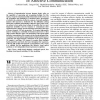Free Online Productivity Tools
i2Speak
i2Symbol
i2OCR
iTex2Img
iWeb2Print
iWeb2Shot
i2Type
iPdf2Split
iPdf2Merge
i2Bopomofo
i2Arabic
i2Style
i2Image
i2PDF
iLatex2Rtf
Sci2ools
TMM
2010
2010
A 3-D Audio-Visual Corpus of Affective Communication
Communication between humans deeply relies on the capability of expressing and recognizing feelings. For this reason, research on human-machine interaction needs to focus on the recognition and simulation of emotional states, prerequisite of which is the collection of affective corpora. Currently available datasets still represent a bottleneck for the difficulties arising during the acquisition and labeling of affective data. In this work, we present a new audio-visual corpus for possibly the two most important modalities used by humans to communicate their emotional states, namely speech and facial expression in the form of dense dynamic 3-D face geometries. We acquire high-quality data by working in a controlled environment and resort to video clips to induce affective states. The annotation of the speech signal includes: transcription of the corpus text into the phonological representation, accurate phone segmentation, fundamental frequency extraction, and signal intensity estimatio...
| Added | 22 May 2011 |
| Updated | 22 May 2011 |
| Type | Journal |
| Year | 2010 |
| Where | TMM |
| Authors | Gabriele Fanelli, Jürgen Gall, Harald Romsdorfer, Thibaut Weise, Luc J. Van Gool |
Comments (0)

